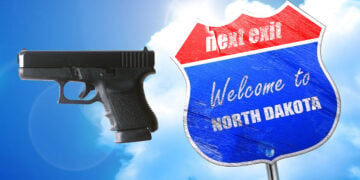We spend an inordinate amount of time sitting in our sedentary 21st Century lifestyle. Despite this, how much time does the average shooter spend practicing shooting from the seated position? In my experience, not much. Many of us spend hours a day sitting in a vehicle. We spend hours a day sitting at a desk or in meetings. What is the likelihood of needing to shoot our defensive handgun while seated? For most, the likelihood of needing to fire our weapon in defense of human life on any given day is small, but within that small likelihood, the possibility of needing to do so from the seated position is quite real. Therefore, if you have never practiced this, I would encourage you to do so. But above all, you need to do so safely.
Safety Concerns and Complications
Drawing and deploying a handgun from concealment while seated introduces several safety considerations beyond the usual standing position. The first pressing matter is that you are much more likely to sweep your own legs or other parts of your body when drawing from the seated position and a safe draw stroke needs to account for this so that you avoid doing so.
Obstructions When Drawing from a Seated Position
A second concern is that when in a seated position, you are likely to be in close proximity to obstructions that can block your draw stroke. If sitting at a table, a desk, or at the steering wheel, your draw can be obstructed, obviously. Also, you must consider the likelihood of others being in close proximity to you, such as next to you in a vehicle or at a table. The key to drawing safely while seated is using a technique that consistently avoids flagging your lower extremities and minimizes the likelihood of obstruction interference.
Where You Carry Greatly Affects Your Draw from a Seated Position
Another issue that can arise when drawing a gun while seated is that the position itself can hinder your draw due to limited mobility. This is particularly true when considering pocket carry, as a gun carried in the pocket becomes more difficult to access in the seated position. Likewise, carrying a gun behind the hip can prove difficult as the seat you may be in can block your access to the weapon. If you spend a lot of time every day in a seated position, which is the case for most of us, this should play a part in your selected carry mode.
Appendix or strong side hip (especially appendix) proves far more accessible than does behind-the-hip or pocket carry. Also, a carry mode that is usually sub-optimal when on your feet is ankle carry, but for a person who spends a great deal of time sitting an ankle carried gun can be beneficial.
Executing the Seated Draw
An effective draw from the seated position will require movement that is brought in close to the body to minimize obstruction. For example, if sitting at a table, a draw stroke that involves wide, sweeping motion, or an upward “bowling” like sweep, will be impeded by the table top. A draw stroke that brings the gun straight up, then pushes it straight out, is the best method. This is no different than the preferred draw stroke taught by most self-defense oriented trainers in which the gun is drawn from the holster and lifted directly to the chest where it is met by the support hand. This direct up and out motion helps to ensure that the gun does not bash into the bottom of a table or steering wheel when in a seated position.
Where this technique can vary from standing, however, is in consideration of the muzzle crossing your own legs. Shooting yourself in the thigh is not an optimal outcome. The upper leg is an exceedingly dangerous place to sustain a wound as the severance of the femoral artery can result in rapid blood loss. Letting the muzzle cross your own legs is simply unacceptable as there is too great a risk of an accident, especially if under the stress of a critical incident. Therefore, a modification of your usually draw stroke may be necessary when you are in the seated position.
Drawing from Strong Side Hip While Seated
If drawing from strong side hip, bringing your legs together, rather than being spread wide, can go a long way in ensuring that the muzzle of the gun does not sweep your thigh when drawing the gun out of the holster. This should be combined with a draw stroke that keeps the muzzle off to the side longer than the typical standing draw. While standing, you can start moving the muzzle in towards your center line once you leave the holster as the gun will be pointing safely at a downward angle in front of you.
While you are seated, however, the muzzle is likely to sweep your thighs or knees if you present the gun in the same way. Therefore, upon drawing the gun up and out of a strong-side holster, keep the gun safely to your side and rotate the muzzle up so that it is pointing straight in front of you before bringing the gun in to meet your support hand.
Drawing from Appendix While Seated
If drawing from appendix, the safest method is to draw the gun straight up while spreading your legs outwards so that the muzzle does not sweep the thighs. Once the gun is out of the holster, the standard presentation can be executed in which the gun comes up to chest level to meet the support hand, then pressed straight out. In reality, a seated draw from appendix carry can actually be performed safely, in which you are less likely to muzzle yourself than strong-side-hip. However, the draw stroke needs to be conducted correctly.
Drawing a handgun from a holster while in the seated position does introduce complications and certain safety concerns. However, the need to do so is possible. Some time should be spent on training yourself to do this properly. Doing so with an empty gun in dry fire certainly makes good sense before moving to live fire. Ensure that a safe and consistent draw stroke is in place before trying it at the range.









